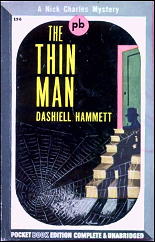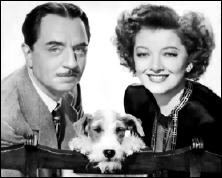Wed 16 Sep 2009
DASHIELL HAMMETT – The Thin Man. Alfred A. Knopf, 1934. Reprinted many times, in both hardcover and paperback, including Pocket #196, 1942.

I read Dashiell Hammett’s The Thin Man back in High School, and I didn’t like it much because it wasn’t The Maltese Falcon. But just lately, some forty years later, I figured I’d give it another try.
I sort of wish I didn’t remember the movie (MGM, 1934) so well, or maybe that the film hadn’t been so faithful to the book. It would have been nice to come back to this fresh, not knowing the ending, just to see how well Hammett constructed this tricky mystery, a tale so well put together that one scarcely knows where to look among a cast of cleverly conceived (and, for the most part, sympathetically observed) suspects — or just what it is we’re looking for.
Is The Thin Man about the murder of Julia West or is it about the con game she was working on the missing Wynant? Is it concerned more with a missing-persons case, or with the kinky, incestuous Wynant family? Whatever the puzzle, it reads quite nicely, with a sense of humor that sneaks up on one very pleasantly indeed.
I might carp that Nick Charles, the narrator/detective, tells the story rather flatly, which contrasts a bit too sharply with the wise-cracks he and Nora keep throwing around in the dialogue. Compare this to the colorful narration Raymond Chandler gave to Philip Marlowe and you’ll see what I mean: Marlowe is a consistent smart-ass, but Nick Charles only gets colorful when he’s talking to the other characters.
But that, as I say, is just carping. The Thin Man has a reputation as a mystery classic, and I was happy to discover how richly it deserves it.

By the way, the movie version, first in a long line of “Thin Man” films, is quite faithful to the book, and generally well thought-of, but it doesn’t hold up quite as well, due largely to a clunky and obvious-red-herring opening sequence (not in the novel) that looks to have been tacked on rather hastily, and someone’s insistence on giving everyone in the cast a Guilty Close-Up.
You know the kind of thing I mean: someone makes a remark or picks up a clue and we cut to a shot of Maureen O’Sullivan or Cesar Romero looking like their pants fell down. It’s the sort of thing they were doing in the Charlie Chan films over at Fox, and it seems embarrassingly out of place in a film that’s mostly fast-moving and sophisticated.
September 16th, 2009 at 12:02 pm
I’m beginning a Hammett revival of my own, and it’s been called to my attention that I have the earlier version of The Thin Man story lurking in an old San Francisco City Magazine somewhere in my storage unit. Gotta find it!
September 16th, 2009 at 1:08 pm
Indeed.
Here’s Dave’s take on THE THIN MAN movie:
http://davycrockettsalmanack.blogspot.com/2009/09/davy-meets-thin-man.html
And here’s his review of THE CONTINENTAL OP:
http://davycrockettsalmanack.blogspot.com/2009/09/hammett-mapback-continental-op.html
With more to come? Take a look.
September 16th, 2009 at 2:45 pm
Hmmm. I’ve always thought that the film actually works slightly better than the original novel. The direction, acting and scripting all work together to give the whole thing a real fizz, whereas the deliberately flat first person narration works against the more colourful dialogue. He’s wisecracking with the other characters, and you sort of wish that he’d spare a wisecrack for you, the reader.
September 16th, 2009 at 7:26 pm
I read this at age 13, having somehow missed the movie and not yet having read Chandler, so the only reference I had for it was the television series with Peter Lawford (which is who the guy on the Bob Abbett cover most resembled). I think because of that my approach to it was less influenced by outside forces Hammett couldn’t have any control of.
For instance Raymond Chandler’s big breakthrough was still four or five years away when The Thin Man was published, so we can assume while this may have influenced Chandler the opposite is unlikely.
This one is not Hammett’s best book — as he himself said of Nick and Nora, no one ever created two more insufferable characters — but in many ways it is his most comfortable book. It’s also his most autobiographical work.
Nora may be an idealized Lillian Hellman, but Nick is Hammett pretty much as he was when he wrote it. The Op, Spade, and Ned Beaumont had all been what Hammett would have liked to have been, but Nick is what he really was — over the hill, alcoholic, a wise-ass, and too observant for his own comfort— or anyone elses.
And for a bright and witty book this one ends on a remarkably dark and sour note — that last line strangely bitter and even just a little cruel all things considered, as if after all the bright byplay and glitter Hammett felt the need to remind us and himself this was about a murder after all.
Still, when I did see the movie and Powell and Loy they became my vision of Nick and Nora, and I think in lightning the tone of the book even more improved on things. But to be honest there is so much going on in the movie that if I hadn’t read the book I don’t think I would remember who did it. Somewhere along the time Nick complains that the bullet came nowhere near his ‘tabloids’ I quit worrying about who the killer was, and just sat back and enjoyed myself.
And that said I think the second film, based on Hammett’s screen story, works better as a film and a mystery.
But I’ve always regretted Nat Pendleton never got to compliment Myrna Loy for having “hair on her chest,” as Guild does in the book.
And one last thing, by the time he wrote The Thin Man Hammett had moved away from the wise cracking narrator. From Falcon on he was developing a style where all of that was saved for dialogue, and the narrative pretty straight forward and even flat. It stands out in The Thin Man because it is the first time Hammett had tried the style in a first person narrative, but that lack of commentary or a look into the character’s mind outside of what they said was very much the style Hammett had developed since Falcon.
And next time you read Falcon try finding a single moment when Hammett tells you what Spade, or anyone else, is thinking outside of dialogue. And then try writing a story, much less a book, without once delving into the characters inner thoughts. Trying to do that in a first person narrative is even harder, and that is probably part of the reason The Thin Man seems a little flat to those of us used to the wise cracking private eye voice where no thought goes unspoken.
September 16th, 2009 at 8:25 pm
Several Hammett collections reprint an unfinished – but fascinating – story called THE FIRST THIN MAN. It’s a 50 page unfinished novel Hammett started. It’s in the collection NIGHTMARE TOWN, for example.
I have no idea how the mystery in THE FIRST THIN MAN will be solved. But very much enjoyed reading it anyway!
September 16th, 2009 at 10:10 pm
And just to confuse things there is also a story called “A Man Named Thin” that has nothing to do with The Thin Man. The hero of The First Thin Man is John Guild, the name of the policeman from The Thin Man.
I’m not sure it is the lost treasure that some Hammett fans insist upon, but it is well worth reading and a fascinating contrast to the more familiar work.
“The Man Named Thin” appears in A Man Called Spade.